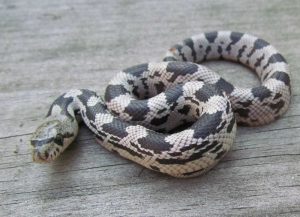Pine Snake
Pine snakes are heavily-built, non-venomous, colubrid snake found near Southeastern US. Although not poisonous, bites from a pine snake are sure to hurt.
Scientific Classification
| Kingdom | Animalia |
| Phylum | Chordata |
| Class | Reptilia |
| Order | Squamata |
| Suborder | Serpentes |
| Family | Colubridae |
| Genus | Pituophis |
| Scientific Name | Pituophis melanoleucus |
Quick Information
| Also known as | Pinesnake, Common pine snake, Black and white snake, Bullsnake, Chicken snake, North American pine snake, Pilot snake, White gopher snake |
| Description | Size: 48-100 in (120-250 cm) in length Weight: 4-8 lb (1.8-3.6 kg) Color: A light background color blotched with brown, black, or brownish-red Sexual Dimorphism: None |
| Distribution & Subspecies | There are three recognized subspecies of the pine snake:
They can be found in the states of Alabama, Georgia, Florida, Kentucky, Mississippi, New Jersey, Louisiana, North Carolina, South Carolina, Tennessee, Virginia, and Delaware |
| Habitat | Prairies, pine-oak woodlands, pine flatwoods, cultivated fields, rocky deserts, and chaparrals |
| Sounds & Calls | Hisses; when confronted they emit a warning sounding by vibrating its epiglottis simultaneously vibrating its tail, thus mimicking a rattlesnake; they also make a loud bellow to appear intimidating |
| Lifespan | The life expectancy in the wild is unknown, but in captivity, they can live for up to 22½ years |
| Diet | Mice, rats, moles, and eggs |
| Adaptations |
|
| Predators | Shrews, raccoons, skunks, red foxes, domestic cats and dogs |
| IUCN Conservation Status | Least Concern |

Northern Pine Snake
Behavior
- Pine snakes are diurnal, being active during the day. Some subspecies, however, exhibit nocturnal habits.
- They are most active between March-April and October-November, spending the rest of the year hibernating through the colder the months.
- They are largely terrestrial but may climb on to trees and small bushes.
- They are foragers and kill their prey by constriction.
- They regulate their body temperature by basking in the sun.
- Females show loyalty to their nesting sites, returning every year.
Mating & Reproduction
These snakes breed once every year. Female breeding cycles occur between April and May. Clutches consisting of 3-24 eggs are laid around June to August. The female lays her eggs under large rocks and sandy burrows. There is no parental care once the eggs are laid. The incubation period lasts for 64-79 days.
Life-cycle
Hatchlings are 13-18 in (33-45 cm). They reach sexual maturity at around 3 years of age.
Interesting Fact
- There are escaped and released pet pine snakes that have established a population in Holland in the forest near Wassenaar.
References:
Published on July 2nd 2018 by Sudipto Chakrabarti under Coniferous Forest Animals.
Article was last reviewed on 5th December 2024.










